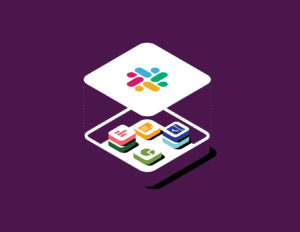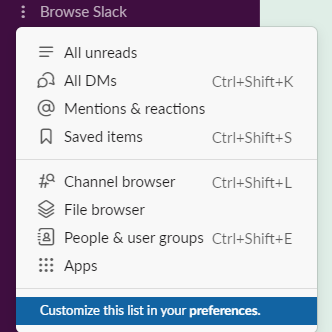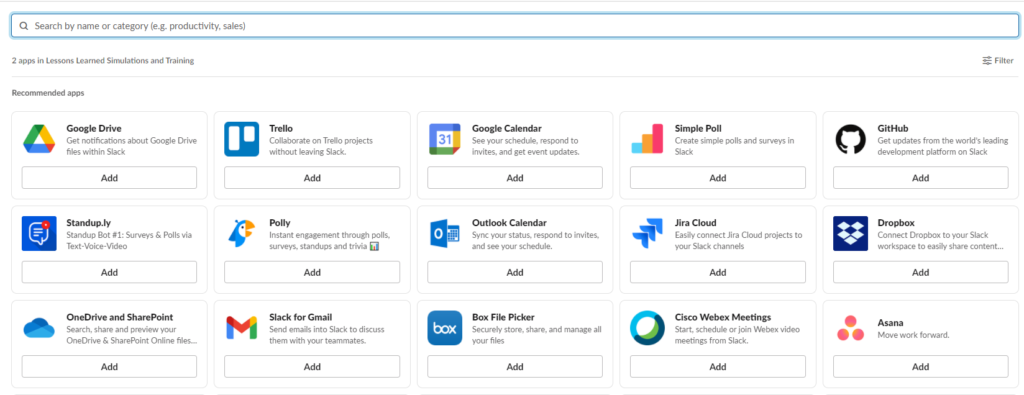Welcome to LLST’s Digital Facilitation Tools Series. In this series we will cover a selection of digital tools, each of which can be used to help facilitate online trainings, simulations, and serious games. Every post in this series will provide an overview of one product, discuss that product’s strengths and weaknesses, examine its accessibility and ease of use, and describe how we see it fitting into the world of online simulation and training. Our series will focus on products that are affordable and easy to access; we plan to showcase a wide variety of tools to help you get started creating your own digital simulations!
Today’s Digital Facilitation Tool is: Slack.
What is Slack?
Slack is a team messaging platform that includes direct and group text communication, video and voice calls, file sharing, and extensive capabilities for integration with other apps. Slack was a created to help businesses organize their forms of communication onto one centralized platform, making communication open, accessible, neatly categorized, and on-task. It markets itself as a sleek and sophisticated alternative to standard email communication.

If you read our piece on Discord, Slack has a very similar interface: a collection of different channels runs along the left-hand side of the screen between which users can hop back-and-forth and instantly message one another about each channel’s specific topic. Slack focuses on collaboration and organization, and its fantastic search bar allows users to quickly and easily track down the information they need.

Slack operates out of your internet browser or through a downloadable application. An excellent free version of Slack allows you to get started right away, though I was disappointed to see that some key features are only available through the paid versions.
Overall, Slack is an excellent business tool that could certainly be leveraged for the purpose of hosting a simulation or training exercise. Slack is ready-built to integrate with over 2,200 third-party applications making it extremely flexible. Slack further claims that through its APIs users have built their own app-integration and now over 650,000 custom apps are used on Slack every week. Certainly, this overview will merely scratch the surface of the multi-faceted abilities that Slack has to offer.
Where Do I Find Slack?
Interested parties can find the browser-version and the Slack application at www.slack.com. Their website also provides a series of helpful tutorials and introductory videos to get you started.
Accessibility, Pricing, and Ease of Use
Slack is available for free and runs directly through your internet browser or through a downloadable app which is available for Windows, iOS, iPhone, and Android. You can sign up for Slack and get started quickly and easily— though to make the most of the platform, I highly recommend spending the time to build specific channels and integrate external applications into your Slack workspace. Personally, I benefitted from taking Slack’s digital tour and watching a tutorial video. Once I put in the time to get a lay of the land, I was very impressed with how easy it became to navigate through Slack, set up channels, search for information, make voice and video calls, share files, and integrate apps.

Inviting others to join your Slack workspace is very straightforward, though anyone who doesn’t create a Slack account will have limited access. There are options to invite new users as full members or as guests; to send invites by email or by a copy-and-paste link; and to automatically accept members who have a company email address.

In addition to the free version, there are three tiers of paid subscriptions to Slack: Standard, Plus, and Enterprise Grid. The Standard and Plus subscriptions cost USD $6.67 and USD $12.50 per month per person, respectively, while the Enterprise Grid is built for very large businesses and requires a negotiation with the sales team. Although the paid versions of Slack are mostly unnecessary for a single simulation or training exercise, some of the omitted features left me rather underwhelmed with the free version. For example, I find it disappointing that screen sharing is disabled for users without a paid Slack subscription when it is a standard feature in the free versions of many other online tools (Zoom, Discord, Google Hangouts, etc.). Additionally, when managing your workspace’s channels— arguably Slack’s cornerstone feature— you are unable to specify posting permissions on any channel other than the #general channel. Yes, you can still make certain channels private and others public, but these restrictions may push me towards programs that provide me more functionality without requiring me to pay for an upgrade.
Slack is supported in 8 different languages: English (US or UK), French (France), German (Germany), Italian, Japanese, Korean, Portuguese (Brazil), and Spanish (Latin America or Spain). Slack does not support any languages that read and write right-to-left, though the website says that Slack hopes to expand its supported languages in the future.
What Are Slack’s Strengths?
Slack excels by providing a clear and organized way to communicate with others online. Through its channel system facilitators can oversee a workspace where the correct information is always delivered to the correct people. Slack is built to handle an incredible amount of communication at once, whether it be group chats, private messages, file sharing, video and voice calls, embedding mp3 files and videos directly into channels, or connecting the information from over 2,200 supported apps— Slack can do all of this at once! On top of that, users are able to access all this information at a later date, making it effective at both simultaneous and asynchronous communication.
If you are concerned about sorting through this deluge of information, Slack’s internal search function has you covered. As someone who has never had a problem with my email’s search function, let me tell you, I did not know what I was missing until I used Slack. Its search bar is easily the most intuitive and helpful search function I have ever used. It offers suggestions to narrow your search down so you can find exactly what you’re looking for effortlessly. I know every search function can do this, so what makes Slack so special, you ask? Slack’s search bar requires no “Advanced Search” options, no “Filters,” and no “Keywords”— it provides you specific options to narrow your search as soon as you click into the search bar. A user can refine their search into a specific channel, look for another member, find messages to or from that member, or find the exact file they’re looking for without any wasted time or effort.

This is not to say that the search bar is the only way for users to keep track of information on Slack. Channels are an effective way to organize conversations, keeping the Slack workspace clean and tidy. Slack is full of small but clever details that assist the flow of information, including the ability to “mention” other users by typing or clicking the @ symbol. By mentioning someone, you can send a notification to specific users, to everyone with channel access, or to everyone currently online, letting them know that you need their attention. If you’re creating a design that asks users to parse through large swaths of information at their own pace, Slack could be the perfect tool to aide them through the process.

As I hinted before, I am most impressed by Slack’s ability to seamlessly integrate with third-party applications. It is the ease at which Slack makes these integrations that has won me over. After a few clicks of my mouse I had integrated my Twitter account with one of our Slack channels, where every tweet, retweet, and mention my account received would provide an update to a private channel. Or, for another example, I was able to quickly connect Zoom to Slack, allowing me to start a brand-new Zoom call and send out invites to a channel full of people simply by entering in the shortcut “/zoom.” Earlier, I was decrying Slack’s omission of screen sharing from its free service; now, with Zoom integration I can share my screen on Zoom without any complicated transition from one program to another. My experiments barely scratched the surface of Slack’s app integration possibilities, but even so, it was immediately obvious how invaluable this capability could become.

What Are Slack’s Weaknesses?
When you use a program like Slack, which attempts to bring the functionality of multiple programs into one centralized space, it is only natural to want to compare it to all the other programs it’s trying to encapsulate. Looking at its channel system, for example, I much prefer the voice and text channels provided in Discord as opposed to the text-only channels found on Slack, which are supplemented by voice and video calls. Additionally, if I or my colleagues preferred voice and video calls, I would then suggest a program like Zoom or Google Hangouts/Meet, where screen sharing is offered freely and there are no extraneous pages of month-old text conversations in which to get lost or distracted.

Slack also suffers from a pitfall that plagues anything that aims to improve upon an already-trusted system: a learning curve. Immediately, Slack advertises itself to be a simpler and superior platform to regular email, but is it really? Slack is a very different program than Gmail, Outlook, Hotmail, Yahoo, or any other popular email provider, and while it can easily facilitate discussions, it is not necessarily “better” than the programs it’s trying to replace. Most internet users are already well trained with a classic email system, utilizing Slack will inevitably lead to a difficult transition. As I touched on in our piece about Google Drive, it is incredibly valuable to use a product that is well known and widely used— while Slack does have a hefty following, it can be incredibly confusing for new users. During a training exercise, you want participants focused on the material, not the delivery system.

Personally, I required a lot of time working with Slack before I felt comfortable with its wide range of features, and it is this broad spectrum of features that makes Slack worthwhile. Thus, if you’re going to use Slack, it feels necessary to invest the time in mastering its intricacies. To me, you need to be ready to dive fully into the Slack experience if you want to take proper advantage of what it has to offer. I would not choose Slack if I were only going to use its most basic features. Slack feels like an all-or-nothing commitment, so make that commitment wisely!

How Would We Use Slack?
In summation, Slack has the potential to be an incredible tool for designers in our field. It is a superb digital gathering space that allows for the centralization of many forms of communication spread across multiple programs. With its easy app integration, I imagine using Slack for a simulation that asks participants to communicate in a variety of different ways. Perhaps a group of participants needs to watch an embedded News-Reel video and post about it on Twitter; meanwhile another group is reacting to that live Twitter feed and discussing the content with another team using text channels; this group must then must deliver a report to the final participants via a video call. Whatever the case, I think Slack has the ability to make a simulation feel large and immersive while not overwhelming any participants.

Slack could also be well used to simulate or recreate a digital office environment, which can be helpful for many training exercises. Slack is effective at both simultaneous and asynchronous communication; its file sharing capabilities are straightforward and dependable. Facilitator controls are adequate in the free version, though if a designer wanted to fully leverage posting permissions, they may have to upgrade Slack or move to a different program.
My advice for prospective designers is to take full advantage of Slack’s multitudinous features or to find another platform for your simulation. Slack is almost like a full digital facilitation toolkit rather than a single tool: if the project is big, you are going to want the full toolkit; if the problem is small, using one specific tool will be far easier.

